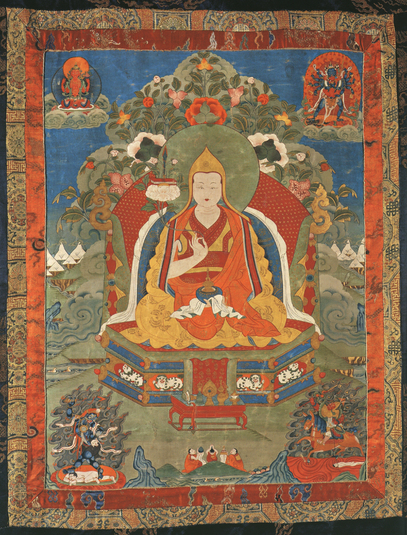
Item: Teacher (Lama) - Dalai Lama VIII, Jampal Gyatso
| Origin Location | Tibet |
|---|---|
| Date Range | 1900 - 1959 |
| Lineages | Gelug and Buddhist |
| Material | Ground Mineral Pigment on Cotton |
| Collection | Private |
Jampal Gyatso, 8th Dalai Lama (1758-1804 [46 yrs]), from a set of paintings depicting the incarnation lineange of the Dalai Lamas of Tibet. See a short biography.
 Biographical details TBRC P109
Biographical details TBRC P109
Jampal Gyatso is identified first by the yellow hat being standard for the Gelug tradition of Tibetan Buddhism to which the Dalai Lamas belong. Secondly, there is the presence of a white lotus, the special attribute of the Dalai Lamas and the drawing of a close comparison with the bodhisattva of compassion Avalokiteshvara. Lastly, the sword and book above the lotus identifies the specific Dalai Lama as Jampal Gyatso whose name is also associated with the bodhisattva of wisdom - Manjushri.
Jampal Gyatso wears the orange, yellow and red attire of a monastic. Surrounding the shoulders and legs is a thick meditation cloak. In the left hand is a black begging bowl with a gold stupa on top. Alternately, he can hold a Dharma wheel as evidenced by comparison with other paintings of Jampa Gyatso. He is seated on a throne decorated with snow lions and a torana throne-back, against a landscape background.
The beginning of the popularization of Dalai Lama incarnation painting sets began during the period of the 7th Dalai Lama Kalzang Gyatso. Numerous sets and partial sets can be found in museums, monasteries and private collections. It is thought by some that a set was prepared at Nartang Monastery based on an earlier model depicting the Panchen Lama incarnation lineage. (See an example of a complete set).
At the top left is Jinasagara Avalikita, red in colour, with four arms. At the upper right is the meditational deity Chakrasamvara and Vajrayogini, blue and red in colour, with multiple faces and arms.
At the bottom right is the worldly protector deity Tsiu Marpo, red in colour, dressed as a warrior, and riding a horse in a sea of blood. At the bottom left is wrathful blue figure, standing, holding a sword and a head.
The dating of the painting to the early 20th century is based on the overall composition, colour palette and decorative features such as the Chinese written character decorating the hat, along with the archaic stylized rock formations and simplistic landscape background.
Jeff Watt 5-2022

Subject: Sword & Book
Collection of the National Museum of Asian Art (Shrine)
Teacher: Dalai Lama VIII, Jampal Gyatso
